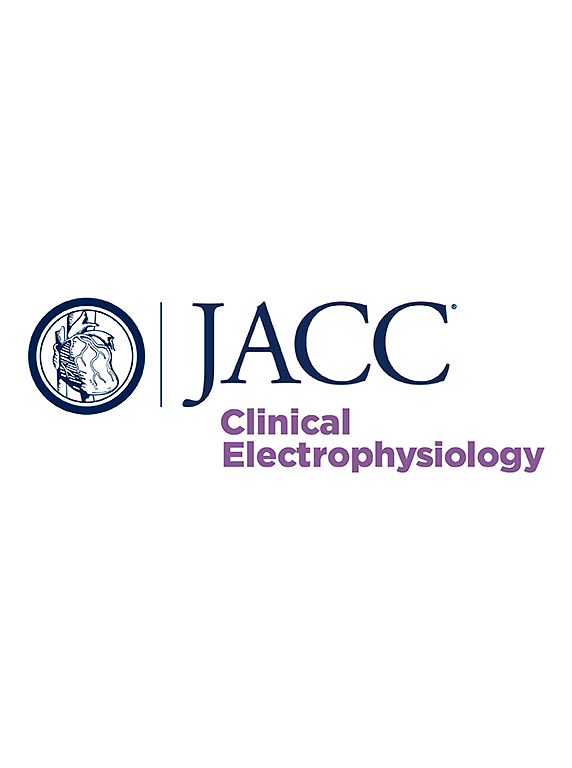Transmural Activation Mapping of Ventricular Arrhythmias With High–Frame Rate Echocardiography and Validation Against Contact Mapping
IF 8
1区 医学
Q1 CARDIAC & CARDIOVASCULAR SYSTEMS
引用次数: 0
Abstract
Background
The restriction of activation mapping to the ventricular surface of contemporary mapping systems often leads to failure to correctly identify the true sites of origin (SoOs) of intramural and/or subepicardial ventricular arrhythmias (VAs), reducing procedural success.
Objectives
The aim of this study was to evaluate if noninvasive electromechanical wave imaging (EWI) can locate the SoOs of VAs along the endo-epicardial axis in patients with and without structural heart disease.
Methods
Patients with VAs requiring ablation underwent preprocedural transthoracic EWI to identify the SoOs and validate using contact mapping. Local electromechanical activation was defined as time point of the downward zero crossing on the incremental axial strain curve. The site of earliest activation on contact mapping and/or successful ablation was employed as ground truth for VA SoO.
Results
Twenty-eight patients underwent EWI, and 25 proceeded to contact mapping (56% men, mean age 53 ± 16 years, mean left ventricular ejection fraction 47% ± 28%, 52% with late gadolinium enhancement (LGE) on magnetic resonance imaging). Five patients were excluded (insufficient or different ventricular tachycardia or ventricular ectopic activity at the time of EWI vs contact mapping). EWI mapping correctly localized the VA SoOs in 17 of 20 (85%) of the cases and mapped them to the adjacent segments in the remaining ones. In the presence of scar, EWI localized 81.8% of the VA SoOs (n = 9 of 11) correctly compared with 88.9% (n = 8 of 9) in patients without (P = NS). The transmural SoOs (endocardial, midmyocardial, or epicardial) were successfully identified in 18 of 20 cases (90%; P = NS for LGE-positive vs LGE-negative patients).
Conclusions
EWI correctly identified the transmural SoOs of focal VAs, including in the presence of scar, in the majority of cases using contact mapping as the gold standard and thus could support preprocedural planning, including requirement for epicardial access and/or ablation techniques. The absence of a true gold standard for clinical transmural mapping remains an important challenge for the validation of novel mapping technologies.
高帧率超声心动图对室性心律失常的跨壁激活映射及对接触映射的验证。
背景:现代测绘系统对心室表面激活测绘的限制常常导致无法正确识别壁内和/或心外膜下室性心律失常(VAs)的真正起源位置(SoOs),从而降低手术成功率。目的:本研究的目的是评估有无结构性心脏病患者的无创机电波成像(EWI)是否可以沿心外膜内轴定位VAs的SoOs。方法:需要消融的VAs患者术前行经胸EWI识别sos并使用接触映射进行验证。局部机电激活定义为增量轴向应变曲线上向下过零的时间点。在接触映射和/或成功消融上最早激活的位置被用作VA SoO的地基真值。结果:28例患者行EWI检查,25例进行接触定位(56%男性,平均年龄53±16岁,平均左室射血分数47%±28%,52%磁共振后期钆增强(LGE))。排除5例患者(EWI与接触测图时室性心动过速或室性异位活动不足或不同)。在20例病例中,有17例(85%)的EWI定位正确,并将其映射到其余病例的邻近节段。在有疤痕的情况下,EWI正确定位了81.8%的VA SoOs (n = 9 / 11),而在没有疤痕的患者中,这一比例为88.9% (n = 8 / 9)。20例患者中有18例(90%;P = NS (lge阳性与lge阴性患者)。结论:在大多数情况下,EWI正确识别局灶性VAs的跨壁SoOs,包括存在疤痕的情况,使用接触测绘作为金标准,因此可以支持手术前计划,包括心外膜通路和/或消融技术的要求。缺乏临床跨壁测绘的真正黄金标准仍然是验证新测绘技术的重要挑战。
本文章由计算机程序翻译,如有差异,请以英文原文为准。
求助全文
约1分钟内获得全文
求助全文
来源期刊

JACC. Clinical electrophysiology
CARDIAC & CARDIOVASCULAR SYSTEMS-
CiteScore
10.30
自引率
5.70%
发文量
250
期刊介绍:
JACC: Clinical Electrophysiology is one of a family of specialist journals launched by the renowned Journal of the American College of Cardiology (JACC). It encompasses all aspects of the epidemiology, pathogenesis, diagnosis and treatment of cardiac arrhythmias. Submissions of original research and state-of-the-art reviews from cardiology, cardiovascular surgery, neurology, outcomes research, and related fields are encouraged. Experimental and preclinical work that directly relates to diagnostic or therapeutic interventions are also encouraged. In general, case reports will not be considered for publication.
 求助内容:
求助内容: 应助结果提醒方式:
应助结果提醒方式:


